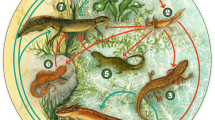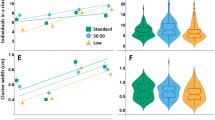Abstract
Synchronous development is widespread throughout the animal kingdom, but how synchrony is achieved remains largely unknown. I examined whether (1) a group-living rhinoceros beetle Trypoxylus dichotomus prepares for pupation (i.e. prepupates) synchronously in the field, (2) whether the synchrony occurs through social interactions, and (3) whether the synchrony incurs physiological costs. I found that larvae prepupate synchronously within natural humus sites. Laboratory experiments show that, when pairs of larvae are placed in the same cage, they prepupate on almost the same day, while two larvae chosen from different cages are expected to prepupate at 6-day intervals. I examined the mechanism of synchronous prepupation by inducing maturity asynchrony between two individuals. Less advanced larvae shortened the larval period in the presence of more advanced neighbours, whilst advanced individuals prolonged the larval periods in the presence of less advanced neighbours. However, variations in the prolongation or shortening of the larval period were dependant on the sites from which the larvae were collected, and in no site did both prolongation and shortening occur together. When the larval periods were prolonged or shortened, the body weight of the resulting pupae decreased. These data show that larvae of this species alter the timing of prepupation depending on the maturity of their neighbours. This developmental plasticity is likely to incur physiological costs due to pupation in suboptimal timing. The pupae and prepupae of this species may gain some benefits such as predator avoidance through the synchrony, which outweigh the cost in terms of reduced body weight.





Similar content being viewed by others
References
Archer MS, Elgar MA (1998) Cannibalism and delayed pupation in hide beetles, Dermestes maculatus DeGeer (Coleoptera: Dermestidae). J Aust Inst Agric Sci 37:158–161
Bauerfeind SS, Fischer K (2005) Effects of food stress and density in different life stages on reproduction in a butterfly. Oikos 111:514–524
Breden F, Kelly C (1982) The effect of conspecific interactions on metamorphosis in Bufo americanus. Ecology 63:1682–1689
Crump ML (1989) Effect of habitat drying on developmental time and size at metamorphosis in Hyla pseudopuma. Copeia 1989:794–797
Esperk T, Tammaru T, Nylin S (2007) Intraspecific variability in the number of larval instars in insects. J Econ Entomol 100:627–646
Etilé E, Despland E (2008) Developmental variation in the forest tent caterpillar: life history consequences of a threshold size for pupation. Oikos 117:135–143
Everaerts C, Farine JP, Cobb M, Ferveur JF (2010) Drosophila cuticular hydrocarbons revisited: mating status alters cuticular profiles. PLoS ONE 5:e9607
Fantinou AA, Perdikis DC, Stamogiannis N (2008) Effect of larval crowding on the life history traits of Sesamia nonagrioides (Lepidoptera: Noctuidae). Eur J Entomol 105:625–630
Hanus R, Vrkoslav V, Hrdy I, Cvacka J, Sobotnik J (2010) Beyond cuticular hydrocarbons evidence of proteinaceous secretion specific to termite kings and queens. Proc Roy Soc B 277:995–1002
Hirashima A, Hirokado S, Tojikubo R, Takeya R, Taniguchi E, Eto M (1998) Metamorphosis of the red flour beetle, Tribolium freemani Hinton (Coleoptera: Tenebrionidae): alteration of octopamine content modulates activity of juvenile-hormone esterase, ecdysteroid level, and pupation. Arch Insect Biochem Physiol 37:33–46
Hoppensteadt FC, Keller JB (1976) Synchronization of periodical cicada emergencies. Science 194:335–337
Hongo Y (2007) Evolution of male dimorphic allometry in a population of the Japanese horned beetle Trypoxylus dichotomus septentrionalis. Behav Ecol Sociobiol 62:245–253
Howard RD (1980) Mating behavior and mating success in woodfrogs, Rana sylvatica. Anim Behav 28:705–716
Hugo LE, Kay BH, Eaglesham GK, Holling N, Ryan PA (2006) Investigation of cuticular hydrocarbons for determining the age and survivorship of Australasian mosquitoes. Am J Trop Med Hyg 74:462–474
Ikeda H, Hirano Y, Ziegler TA, Saigusa M (2006) Induction of hatching by chemical signals secreted from ovigerous female of an estuarine crab Sesarma haematocheir. J Exp Zool 305:459–471
Ims RA (1990) On the adaptive value of reproductive synchrony as a predator-swamping strategy. Am Nat 136:485–498
Karban R (1982) Increased reproductive success at high densities and predator satiation for periodical cicadas. Ecology 63:321–328
Karban R, Black CA, Weinbaum SA (2000) How 17-year cicadas keep track of time. Ecol Lett 3:253–256
Kingsolver JG (2007) Variation in growth and instar number in field and laboratory Manduca sexta. Proc Roy Soc B 274:977–981
Koenig WD, Liebhold AM (2013) Avian predation pressure as a potential driver of periodical cicada cycle length. Am Nat 181:145–149
Kojima W, Takanashi T, Ishikawa Y (2012a) Vibratory communication in the soil: pupal signals deter larval intrusion in a group-living beetle Trypoxylus dichotoma. Behav Ecol Sociobiol 66:171–179
Kojima W, Ishikawa Y, Takanashi T (2012b) Pupal vibratory signals of a group-living beetle that deter larvae: are they mimics of predator cues? Comm Integ Biol 5:262–264
Kojima W, Ishikawa Y, Takanashi T (2012c) Deceptive vibratory communication: pupae of a beetle exploit the freeze response of larvae to protect themselves. Biol Lett 8:517–520
Kojima W, Ishikawa Y, Takanashi T (2014) Chemically mediated group formation in soil-dwelling larvae and pupae of the beetle Trypoxylus dichotomus. Naturwissenschaften 101:687–695
Krause J, Ruxton GD (2002) Living in groups. Oxford University Press, Oxford
Lack D (1968) Ecological adaptations for breeding in birds. Methuen & Co, Ltd, London
Lane SJ, Mahony MJ (2002) Larval anurans with synchronous and asynchronous development periods: contrasting responses to water reduction and predator presence. J Anim Ecol 71:780–792
Loman J (1999) Early metamorphosis in common frog Rana temporaria tadpoles at risk of drying: an experimental demonstration. Amph-Rept 20:421–430
Marlatt CL (1907) The periodical cicada. Bull USDA Bur Entomol 71:1–181
McGlashan J, Spencer RJ, Old J (2012) Embryonic communication in the nest: metabolic responses of reptilian embryos to developmental rates of siblings. Proc Roy Soc B 279:1709–1715
Miramontes O, DeSouza O (1996) The non-linear dynamics of survival and social facilitation in termites. J Theor Biol 181:373–380
Mukai H, Hironaka M, Tojo S, Nomakuchi S (2012) Maternal vibration induces synchronous hatching in a subsocial burrower bug. Anim Behav 84:1443–1448
Mukai H, Hironaka M, Tojo S, Nomakuchi S (2014) Maternal vibration: an important cue for embryo hatching in a subsocial shield bug. PLoS ONE 9:e87932
O’Donoghue M, Boutin S (1995) Does reproductive synchrony affect juvenile survival rates of northern mammals? Oikos 74:115–121
Pechenik JA, Rittschof D, Schmidt AR (1993) Influence of delayed metamorphosis on survival and growth of juvenile barnacles Balanus amphitrite. Mar Biol 115:287–294
Persson I, Andersson G (1999) Intraclutch hatch synchronization in pheasants and mallard ducks. Ethology 105:1087–1096
Peters TM, Barbosa P (1977) Influence of population density on size, fecundity, and developmental rate of insects in culture. Annu Rev Entomol 22:431–450
Ryan TJ, Winne CT (2001) Effects of hydroperiod on metamorphosis in Rana sphenocephala. Am Midl Nat 145:46–53
Shafiei M, Moczek AP, Nijhout HF (2001) Food availability controls the onset of metamorphosis in the dung beetle Onthophagus taurus (Coleoptera: Scarabaeidae). Physiol Entomol 26:173–180
Smith DC (1987) Adult recruitment in chorus frogs—effects of size and date at metamorphosis. Ecology 68:344–350
Spencer RJ, Thompson MB, Banks PB (2001) Hatch or wait? A dilemma in reptilian incubation. Oikos 93:401–406
Spencer RJ, Janzen FJ (2011) Hatching behavior in turtles. Integr Comp Biol 51:100–110
Sweeney BW, Vannote RL (1982) Population synchrony in mayflies: a predator satiation hypothesis. Evolution 36:810–821
Tanaka A (1981) Regulation of body size during larval development in the German cockroach, Blattella germanica. J Insect Physiol 27:587–592
Telang A, Frame L, Brown MR (2007) Larval feeding duration affects ecdysteroid levels and nutritional reserves regulating pupal commitment in the yellow fever mosquito Aedes aegypti Diptera: Culicidae. J Exp Biol 210:854–864
Tejedo M, Reques R (1994) Plasticity in metamorphic traits of natterjack tadpoles: the interactive effects of density and pond duration. Oikos 71:295–304
Thomforde LL, Fremling CR (1968) Synchronous emergence of Hexagenia bilineata mayflies in the laboratory. Ann Entomol Soc Am 61:1235–1239
Tschinkel WR, Willson CD (1971) Inhibition of pupation due to crowding in some tenebrionid beetles. J Exp Zool 176:137–146
Tsurumaki H (1987) Collecting and breeding of the Japanese rhinoceros beetle. Saishu To Shiiku 49:254–257 (in Japanese)
Tucker JK, Paukstis GL, Janzen FJ (2008) Does predator swamping promote synchronous emergence of turtle hatchlings among nests? Behav Ecol 19:35–40
Vince MA (1969) Embryonic communication, respiration and the synchronization of hatching. In: Hinde LA (ed) Bird Vocalizations. Cambridge University Press, Cambridge, pp 233–260
Walsh PT, Downie JR, Monaghan P (2008) Predation-induced plasticity in metamorphic duration in Xenopus laevis. Funct Ecol 22:699–705
Wassersug RJ (1973) Aspects of social behavior of anuran larvae. In: Vial JL (ed) Evolutionary biology of the anurans: contemporary research on major problems. University of Missouri Press, Columbia, pp 273–297
Xu H, Ye GY, Xu Y, Hu C, Zhu GH (2014) Age–dependent changes in cuticular hydrocarbons of larvae in Aldrichina grahami (Aldrich) (Diptera: Calliphoridae). Forensic Sci Int 242:236–241
Yamanaka M, Fujiwara S (1994) Does larval diapause occur in Trypoxylus dichotomus? New Entomol 43:60–64 (in Japanese)
Acknowledgements
I thank T. Saga for collection of field data; Y. Okada and two anonymous reviewers for constructive suggestions and invaluable comments on the manuscript; S. Hoshizaki and M. Abe for advice on the analyses; and M. Shimada for his help and suggestions throughout study. The Research Fellowship for Young Scientists provided by the Japan Society for the Promotion of Science was greatly appreciated.
Author information
Authors and Affiliations
Corresponding author
Additional information
Communicated by J. C. Choe
Electronic supplementary material
Below is the link to the electronic supplementary material.
ESM 1
(DOCX 61 kb)
Rights and permissions
About this article
Cite this article
Kojima, W. Mechanism of synchronous metamorphosis: larvae of a rhinoceros beetle alter the timing of pupation depending on maturity of their neighbours. Behav Ecol Sociobiol 69, 415–424 (2015). https://doi.org/10.1007/s00265-014-1854-0
Received:
Revised:
Accepted:
Published:
Issue Date:
DOI: https://doi.org/10.1007/s00265-014-1854-0




